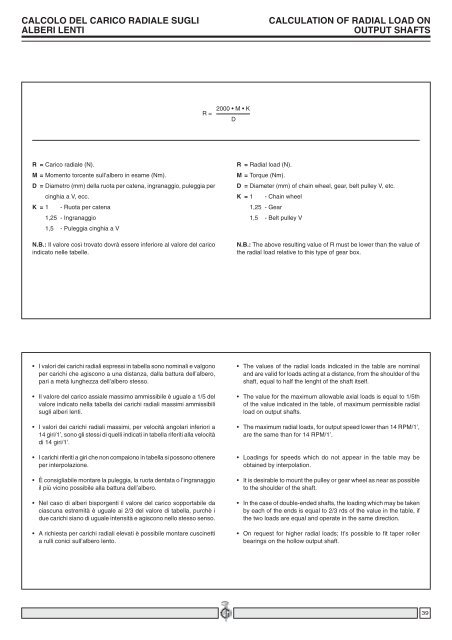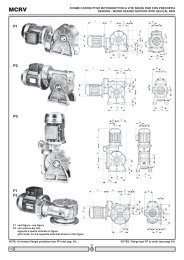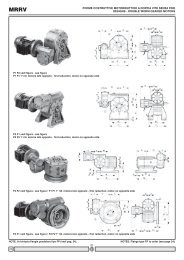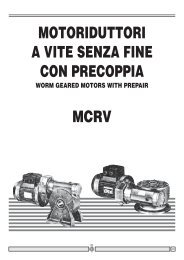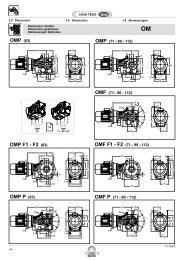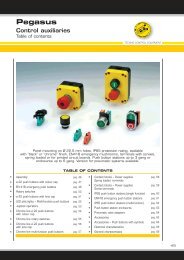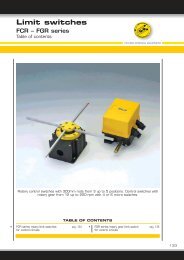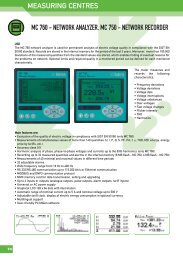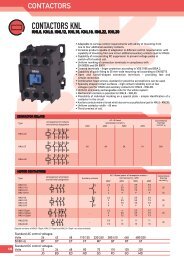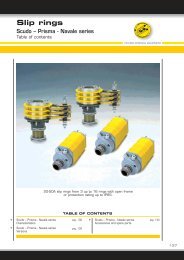catalogo generale n. 10 - Transmo
catalogo generale n. 10 - Transmo
catalogo generale n. 10 - Transmo
Create successful ePaper yourself
Turn your PDF publications into a flip-book with our unique Google optimized e-Paper software.
CALCOLO DEL CARICO RADIALE SUGLI<br />
ALBERI LENTI<br />
CALCULATION OF RADIAL LOAD ON<br />
OUTPUT SHAFTS<br />
R =<br />
2000 • M • K<br />
D<br />
R = Carico radiale (N).<br />
M = Momento torcente sull’albero in esame (Nm).<br />
D = Diametro (mm) della ruota per catena, ingranaggio, puleggia per<br />
K = 1<br />
cinghia a V, ecc.<br />
- Ruota per catena<br />
1,25 - Ingranaggio<br />
1,5 - Puleggia cinghia a V<br />
N.B.: Il valore così trovato dovrà essere inferiore al valore del carico<br />
indicato nelle tabelle.<br />
R = Radial load (N).<br />
M = Torque (Nm).<br />
D = Diameter (mm) of chain wheel, gear, belt pulley V, etc.<br />
K = 1<br />
- Chain wheel<br />
1,25 - Gear<br />
1,5 - Belt pulley V<br />
N.B.: The above resulting value of R must be lower than the value of<br />
the radial load relative to this type of gear box.<br />
• I valori dei carichi radiali espressi in tabella sono nominali e valgono<br />
per carichi che agiscono a una distanza, dalla battura dell’albero,<br />
pari a metà lunghezza dell’albero stesso.<br />
• Il valore del carico assiale massimo ammissibile è uguale a 1/5 del<br />
valore indicato nella tabella dei carichi radiali massimi ammissibili<br />
sugli alberi lenti.<br />
• I valori dei carichi radiali massimi, per velocità angolari inferiori a<br />
14 giri/1’, sono gli stessi di quelli indicati in tabella riferiti alla velocità<br />
di 14 giri/1’.<br />
• I carichi riferiti a giri che non compaiono in tabella si possono ottenere<br />
per interpolazione.<br />
• È consigliabile montare la puleggia, la ruota dentata o l’ingranaggio<br />
il più vicino possibile alla battura dell’albero.<br />
• Nel caso di alberi bisporgenti il valore del carico sopportabile da<br />
ciascuna estremità è uguale ai 2/3 del valore di tabella, purchè i<br />
due carichi siano di uguale intensità e agiscono nello stesso senso.<br />
• A richiesta per carichi radiali elevati è possibile montare cuscinetti<br />
a rulli conici sull’albero lento.<br />
• The values of the radial loads indicated in the table are nominal<br />
and are valid for loads acting at a distance, from the shoulder of the<br />
shaft, equal to half the lenght of the shaft itself.<br />
• The value for the maximum allowable axial loads is equal to 1/5th<br />
of the value indicated in the table, of maximum permissible radial<br />
load on output shafts.<br />
• The maximum radial loads, for output speed lower than 14 RPM/1’,<br />
are the same than for 14 RPM/1’.<br />
• Loadings for speeds which do not appear in the table may be<br />
obtained by interpolation.<br />
• It is desirable to mount the pulley or gear wheel as near as possible<br />
to the shoulder of the shaft.<br />
• In the case of double-ended shafts, the loading which may be taken<br />
by each of the ends is equal to 2/3 rds of the value in the table, if<br />
the two loads are equal and operate in the same direction.<br />
• On request for higher radial loads; It’s possible to fit taper roller<br />
bearings on the hollow output shaft.<br />
39


